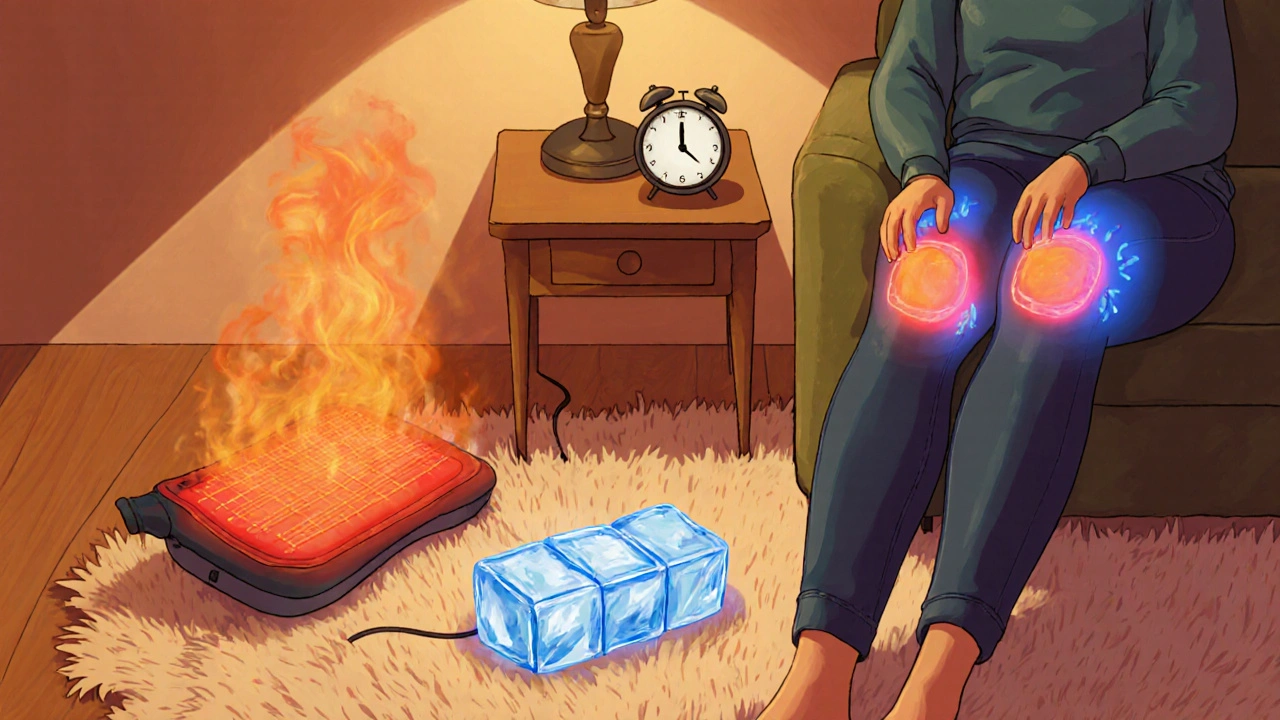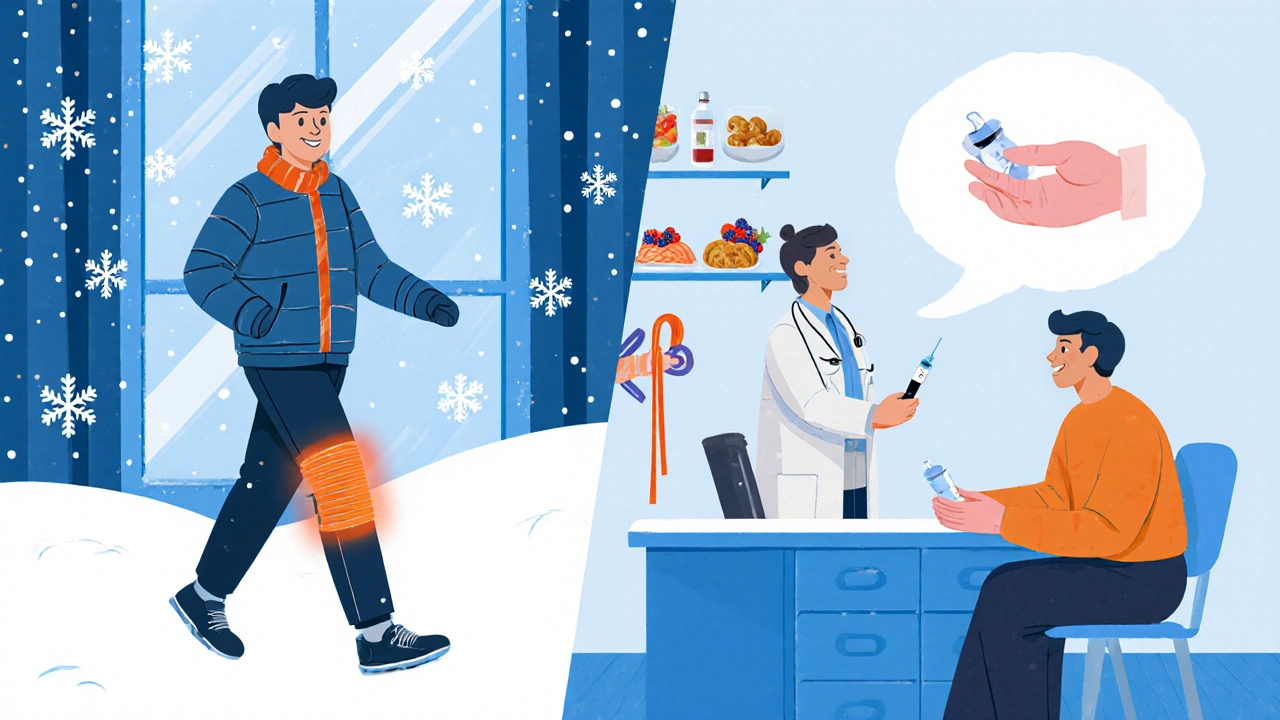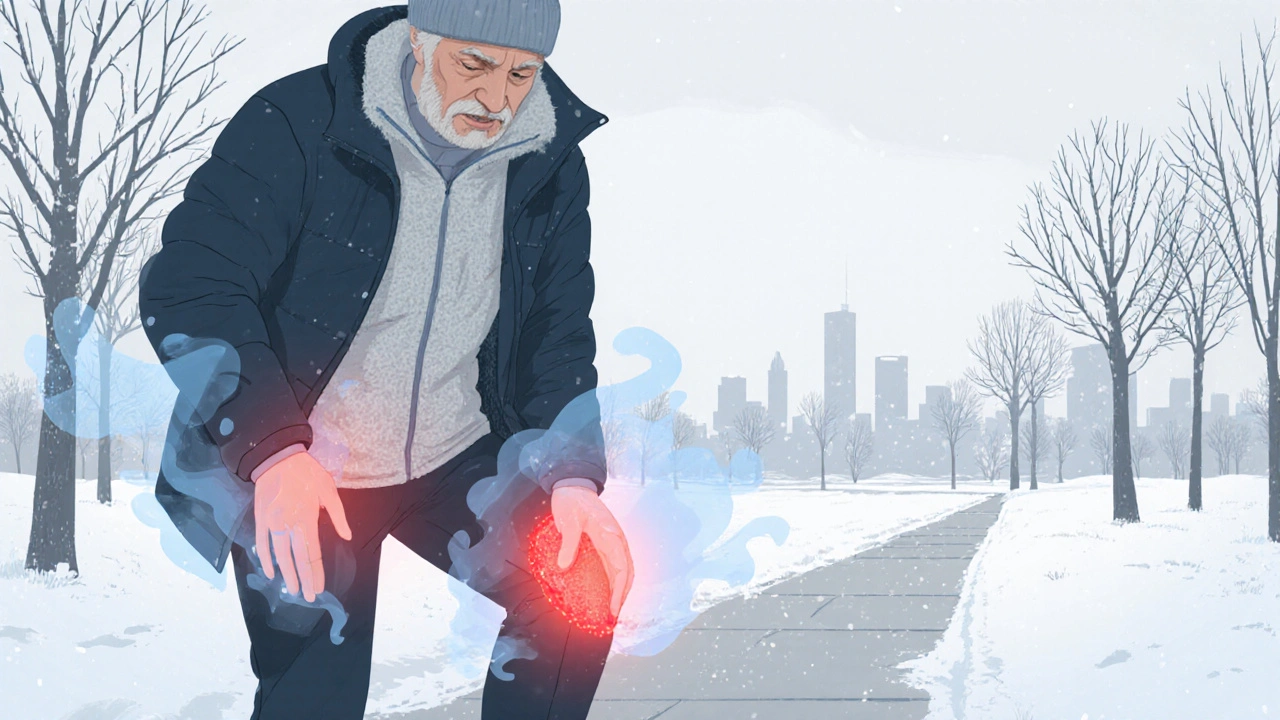Bursitis Therapy Calculator
Find the Right Therapy for Your Bursitis
Select your symptoms to determine whether heat or cold therapy is most appropriate.
Recommended Therapy
Select your symptoms to see the recommendation
Key Takeaways
- Cold weather can aggravate bursitis pain by tightening tissues and reducing circulation.
- Layered, breathable clothing and regular movement keep joints warm without over‑heating.
- Heat therapy eases stiffness, while brief cold packs reduce flare‑ups - know when to use each.
- Non‑steroidal anti‑inflammatory drugs (NSAIDs) and an anti‑inflammatory diet provide systemic relief.
- If pain persists beyond two weeks of self‑care, seek professional assessment for injections or advanced therapy.
What Happens to Bursitis When Winter Arrives?
Bursitis is a painful inflammation of the fluid‑filled sacs (bursae) that cushion bones, tendons and muscles near joints. In colder months, the surrounding muscles and tendons contract, limiting the natural glide of the bursae. Reduced blood flow slows the removal of inflammatory by‑products, which can turn a mild ache into a stubborn ache. Many people notice their shoulder, hip or knee bursitis flaring up when the temperature drops below 10°C (50°F). Understanding this seasonal trigger is the first step toward effective management.
Layer Smartly: Clothing and Activity Adjustments
Keeping the affected joint warm without trapping sweat is a balancing act. Opt for moisture‑wicking base layers, a mid‑weight fleece, and a wind‑proof outer shell. For the knee or elbow, a snug compression sleeve adds gentle heat and reduces swelling.
Compression sleeve provides graduated pressure that supports the joint while encouraging blood circulation. Wear it during early morning walks or before a workout, but remove it during rest periods to let the skin breathe.
Movement matters, too. Short, frequent walks (5-10minutes) every hour prevent stiffness. If you sit for long periods, set a timer to stand, stretch, and swing the arms or rotate the hips gently.

Home Therapies: Heat vs. Cold
Both heat and cold are inexpensive, accessible tools, but they serve opposite purposes. Heat dilates blood vessels, delivers oxygen‑rich blood, and relaxes tight muscles. Cold constricts vessels, numbs nerve endings, and limits swelling.
| Aspect | Heat Therapy | Cold Therapy |
|---|---|---|
| Goal | Loosen stiff tissues, increase circulation | Reduce acute inflammation, numb pain |
| When to Use | Chronic stiffness, morning pain, before activity | Sudden flare‑up, swelling, after activity |
| Typical Duration | 15‑20minutes, 2‑3 times daily | 10‑15minutes, up to 4 times daily |
| Methods | Warm towel, heating pad (≤45°C), warm water soak | Ice pack wrapped in cloth, frozen peas, gel cold pack |
Start each day with a gentle heat application for 15minutes, then finish any vigorous activity with a brief cold pack to curb swelling. Alternate the two on days when the weather swings between warm afternoons and chilly mornings.
Medication and Supplements: What Works Best in Winter?
The most common over‑the‑counter option is a non‑steroidal anti‑inflammatory drug. These medications inhibit cyclooxygenase enzymes, reducing the production of prostaglandins that drive pain and swelling.
NSAIDs such as ibuprofen or naproxen, provide systemic relief by targeting inflammation pathways. Take them with food to protect the stomach lining, and limit use to the recommended maximum daily dose.
If you prefer a natural route, consider an anti‑inflammatory diet rich in omega‑3 fatty acids, antioxidants and low‑glycemic vegetables. Foods like salmon, walnuts, berries, leafy greens and turmeric have been shown to lower cytokine levels that aggravate bursitis.
Anti‑inflammatory diet emphasizes omega‑3s, polyphenols, and fiber to modulate the body’s inflammatory response. Aim for three servings of fatty fish per week and add a teaspoon of ground turmeric to soups or smoothies.
Supplements such as glucosamine or chondroitin may support joint cartilage health, though evidence for bursitis is mixed. If you try them, monitor any changes for at least six weeks.
Glucosamine is a natural compound that contributes to cartilage repair and may ease joint discomfort.
Targeted Exercise and Physiotherapy
Guided movement keeps the bursae lubricated and prevents the surrounding muscles from tightening. A physiotherapist can design a program that respects winter’s lower ambient temperature while still challenging the joint.
Physiotherapy uses manual techniques, therapeutic exercises, and modalities to restore function and reduce pain. Typical sessions include gentle range‑of‑motion drills, isotonic strengthening, and proprioceptive training.
Examples of winter‑friendly exercises:
- Wall slides - stand with back to a wall, slide arms upward while keeping elbows soft.
- Seated hip marches - sit tall, lift one knee, lower, then the other; keep a steady rhythm.
- Theraband external rotation - attach a light band to a door handle, keep elbow at waist, rotate forearm outward.
Perform each move for 2minutes, three times daily. Warm up with a light heat pad for 5minutes before starting; this mimics the body’s natural rise in temperature during activity.

When to Seek Professional Care
If pain remains intense (>7/10) after two weeks of diligent self‑care, or if you notice bruising, fever, or loss of joint function, it’s time to see a clinician. They may recommend:
- Ultrasound‑guided corticosteroid injection to rapidly quell inflammation.
- Diagnostic imaging (MRI or ultrasound) to rule out infection or other joint pathology.
- Referral to an orthopaedic surgeon if bursitis recurs despite conservative measures.
Corticosteroid injection delivers a powerful anti‑inflammatory medication directly into the bursa, providing rapid symptom relief. The effect can last weeks to months, but repeats should be limited to avoid tissue weakening.
Quick Winter Bursitis Checklist
- Dress in layers; include a breathable compression sleeve on the affected joint.
- Do a 5‑minute light warm‑up with a heating pad before any activity.
- Move every hour - short walks or gentle stretches keep synovial fluid flowing.
- Apply cold for 10‑15minutes after any aggravating activity.
- Take NSAIDs with food if pain spikes; limit to 7‑10 days unless advised otherwise.
- Eat an anti‑inflammatory diet rich in omega‑3s and antioxidants.
- Schedule a physiotherapy session if stiffness persists beyond a week.
- Contact a health professional if pain exceeds 7/10 or swelling worsens.
Frequently Asked Questions
Can I use a hot water bottle instead of a heating pad?
Yes, a hot water bottle works as long as the temperature stays below 45°C and you wrap it in a cloth to avoid skin burns. Rotate it every 15minutes to prevent overheating the tissue.
Are there specific foods that worsen bursitis in winter?
Highly processed meats, sugary snacks, and trans‑fat laden fast food can increase systemic inflammation, making winter flare‑ups more likely. Cutting back on these items often reduces pain intensity.
How long should I wait before trying a corticosteroid injection?
Most clinicians recommend exhausting at‑home measures for 2‑3weeks. If pain remains severe or functional loss persists, discuss injection options during that window.
Is swimming safe for bursitis during winter?
Indoor swimming in a heated pool provides low‑impact movement that warms the joint, making it an excellent winter exercise. Avoid very cold outdoor water, which can trigger stiffness.
Should I continue taking NSAIDs if I have a history of stomach ulcers?
Talk to a doctor first. They may suggest a COX‑2 selective NSAID or add a proton‑pump inhibitor to protect the stomach lining.


Graham Holborn
Hi, I'm Caspian Osterholm, a pharmaceutical expert with a passion for writing about medication and diseases. Through years of experience in the industry, I've developed a comprehensive understanding of various medications and their impact on health. I enjoy researching and sharing my knowledge with others, aiming to inform and educate people on the importance of pharmaceuticals in managing and treating different health conditions. My ultimate goal is to help people make informed decisions about their health and well-being.